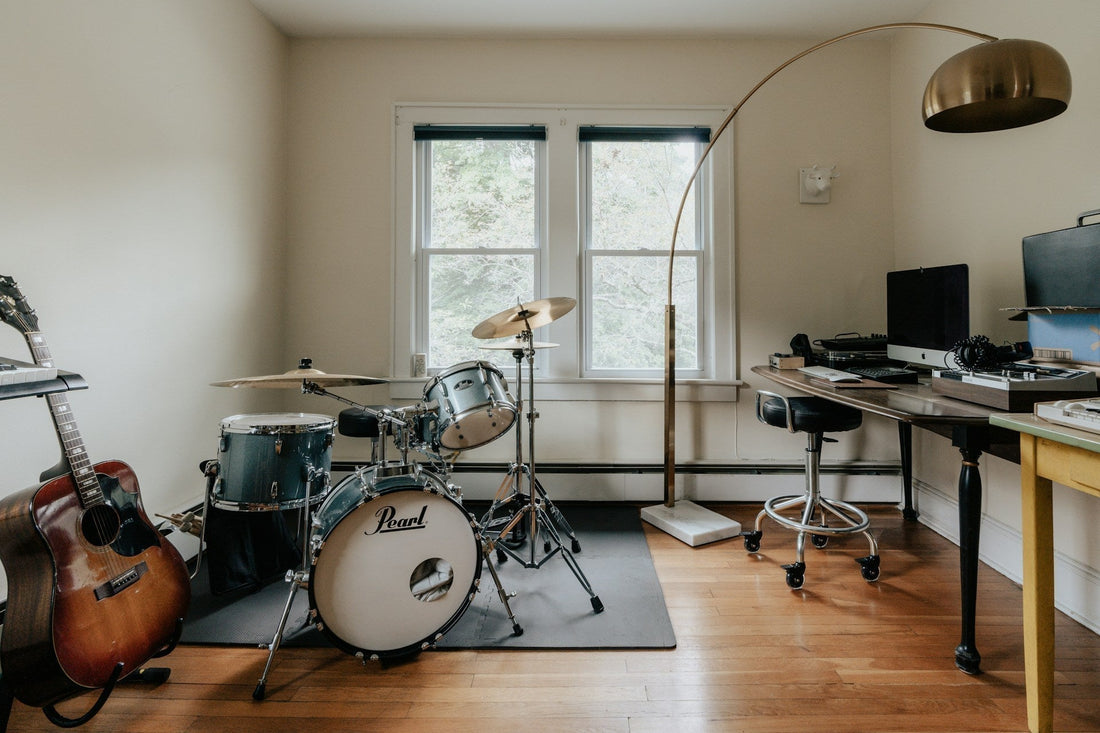
How to Make a Landlord-Friendly Music Space in Your Apartment
Partager
Making music and kickstarting your career as a producer, singer, beatmaker, or DJ can be rough when you don’t have your own space.
Landlords can be tight with what you can and can’t do in the space. They don’t want you damaging or altering the property, and there may be sound restrictions and neighbours to consider.
You may find yourself desperately looking for a place you can make music, be creative when and how you want to be creative, and keep everyone happy. The perfect balance between immersing yourself in your passion and chasing your goals, and not getting kicked out of your home.
The truth is, thousands of musicians, podcasters, and content creators successfully maintain professional music spaces in rental properties. They've learned to navigate noise ordinances, build relationships with landlords, and create professional setups that enhance rather than damage their living spaces.
This isn't about compromise—it's about strategy. The right approach transforms you from "that noisy tenant" into "that professional artist" who adds value to the property.
Can you legally make music in a rental apartment?
 Yes, tenants have the right to reasonable use of their rental property, including music practice during appropriate hours.
Yes, tenants have the right to reasonable use of their rental property, including music practice during appropriate hours.
UK law generally permits household activities, including playing music at reasonable volumes between 7 AM and 11 PM, though specific lease terms and local noise ordinances may impose additional restrictions.
Your legal foundation starts with the right to quiet enjoyment, which works both ways.
While you have the right to live peacefully without unreasonable interference, you also have the responsibility not to disturb others. This means reasonable music practice is legally protected, but excessive noise can trigger legal consequences.
In the UK, noise levels between 11 PM and 7 AM shouldn't exceed 34 dBA in quiet environments, or 10 dBA above background noise levels.
During daytime hours, the threshold focuses on whether noise constitutes a "statutory nuisance"—unreasonable interference with neighbours' quality of life.
What do UK noise laws say about music practice hours?
 UK councils can investigate noise complaints at any time, but focus enforcement on night hours (11 PM to 7 AM) when lower noise thresholds apply. General guidance suggests music at reasonable volumes between 7 AM and 11 PM is usually acceptable.
UK councils can investigate noise complaints at any time, but focus enforcement on night hours (11 PM to 7 AM) when lower noise thresholds apply. General guidance suggests music at reasonable volumes between 7 AM and 11 PM is usually acceptable.
Daytime music practice (7 AM to 11 PM) operates under more lenient standards. Metropolitan Police suggest avoiding music disputes by reaching "amicable compromise, such as no music after 11 pm", indicating authorities expect reasonable daytime music to be tolerated.
Context matters significantly. Environmental health officers consider "volume, frequency, and how it affects neighbours" rather than rigid time limits. One hour of moderate practice differs from three hours of amplified rehearsal, regardless of time.
The practical approach here is to communicate proactively, whatever your circumstances.
Most noise ordinances encourage talking to neighbours before they involve authorities, and establishing practice schedules reduces conflict potential dramatically.
When you can work with your neighbours, and have them feel comfortable contacting you when they need some peace and quiet, or if you want to ask when’s a good time to practice, you’ll nurture much better relationships where everyone feels like they’re respected.
Without having to face legal consequences right off the bat.
How do you approach landlords about music equipment and practice?
Be transparent during the application process, emphasise your professionalism, and propose specific solutions like practice schedules and acoustic treatment.
Focus on how your music enhances the property value and your reliability as a tenant rather than making it seem like a potential problem.
Frame it professionally, not as a hobby. "I'm a music producer who works from home" sounds more legitimate than "I like to jam with friends." Emphasise the professional nature: deadlines, client or label meetings, structured schedules.
Propose specific solutions before they ask. "I practice weekdays 2-6 PM and use professional acoustic treatment", demonstrating forethought and consideration. Mention noise-reduction measures, time limitations, and neighbour communication strategies.
Offer concrete compromises:
-
Practice hour restrictions (weekdays only, no evenings after 8 PM)
-
Acoustic treatment installation (removable panels, professional materials)
-
Neighbour introduction meetings (building relationships proactively)
-
Volume monitoring (decibel meters, professional awareness)
What acoustic treatment can you install without damage?
 Command strips can safely hold lightweight acoustic panels on smooth surfaces without damaging walls, supporting up to 10kg (20lb) with four pairs of extra-large strips.
Command strips can safely hold lightweight acoustic panels on smooth surfaces without damaging walls, supporting up to 10kg (20lb) with four pairs of extra-large strips.
AudioSilk acoustic treatment panels are actually designed with this in mind and are perfect for rentals due to their non-destructive installation.
Alternative mounting methods avoid wall contact entirely:
-
Portable acoustic screens on wheels for recording areas
-
Floor-standing panel systems using photography backdrop stands
-
Furniture-mounted treatment using bookshelves and fabric panels
However, those other methods can take up a lot of space and be very awkward and fiddly. Instead, focus on panels and existing furniture placement.
How do you build relationships with neighbours and avoid complaints?
Introduce yourself proactively, explain your schedule and profession, exchange contact information, and establish clear communication channels. Most neighbours appreciate advance notice and professional communication over surprise noise.
-
The introduction visit sets the foundation for long-term success. Knock on immediate neighbours' doors within your first week, introduce yourself professionally, and explain your work briefly. "I'm a music producer who works from home" establishes context without sounding threatening.
-
Share your schedule proactively. "I typically record weekdays from 2-6 PM", giving neighbours predictability and demonstrating consideration. Include your contact information and invite them to reach out with any concerns.
-
Establish communication protocols. "Please text me directly if anything gets too loud—I'd rather hear from you immediately than have ongoing problems" shows respect and creates direct resolution pathways.
-
Address complaints professionally when they arise. Thank neighbours for direct communication, acknowledge their concerns specifically, and propose concrete solutions. "Thank you for letting me know—I'll keep the bass lower after 7 PM" shows respect and problem-solving focus.
If things get tense or awkward, there’s no need to hide or feel ashamed. Address things considerately and confidently, and aim to work as a team where everyone is heard and given a chance to share their thoughts.
What equipment works best for apartment music setups?
Choose compact, versatile gear that prioritises headphone monitoring and digital processing over amplified sound. Focus on USB interfaces, closed-back headphones, software-based effects, and instruments with direct input capabilities.
Headphone-centric workflows eliminate most neighbour complaints while maintaining professional quality. Professional mixing engineers work this way, learning to calibrate their monitoring through quality closed-back headphones. Use reference tracks to understand your headphone's response.
Compact recording chains maximise results while minimising space and noise:
-
USB microphones (Audio-Technica AT2020USB+, Shure MV7) for broadcast quality
-
Small audio interfaces (Focusrite Scarlett series) for multiple inputs
-
Laptop-based DAWs eliminate desktop computer fan noise
-
Portable microphone stands that pack away completely
Volume monitoring tools help maintain neighbour relationships:
-
Smartphone decibel meter apps for objective measurement
-
Visual monitoring software showing output levels
-
Reference volume settings marked on the equipment
How do you document everything for deposit protection?
 Photograph all walls before installation, save packaging and instructions for all mounting hardware, document neighbour interactions, and maintain records of any modifications to the property.
Photograph all walls before installation, save packaging and instructions for all mounting hardware, document neighbour interactions, and maintain records of any modifications to the property.
Pre-installation documentation establishes baseline conditions:
-
High-resolution photos of every wall surface before any treatment
-
Document existing damage, scratches, or imperfections already present
-
Date-stamped evidence for legal protection
Installation process records demonstrate proper technique:
-
Save all mounting hardware packaging showing weight limits and instructions
-
Document each installation step following the manufacturer guidelines
-
Compliance evidence proving you followed all package directions
Communication documentation protects against disputes:
-
Email chains with landlords about acoustic treatment permissions
-
Text messages showing neighbour cooperation and problem-solving
-
Written records of how you addressed any concerns
Wrapping up
Be the tenant landlords love. Professional communication, acoustic improvements that add value, and zero damage to walls. Document everything, respect noise limits, and position yourself as someone who enhances the property.
Ready to build your dream studio without the deposit drama?
AudioSilk panels solve the renter's dilemma: professional acoustic performance with zero permanent installation. Mount in 30 seconds with Command strips. Remove without a trace when you move out. Landlords actually appreciate tenants who improve acoustics—it adds property value.
Get your acoustic treatment panels today →
From bedroom studios to apartment podcasts, transform any rental space into a professional creative environment. Your deposit stays safe, and your sound gets professional.



